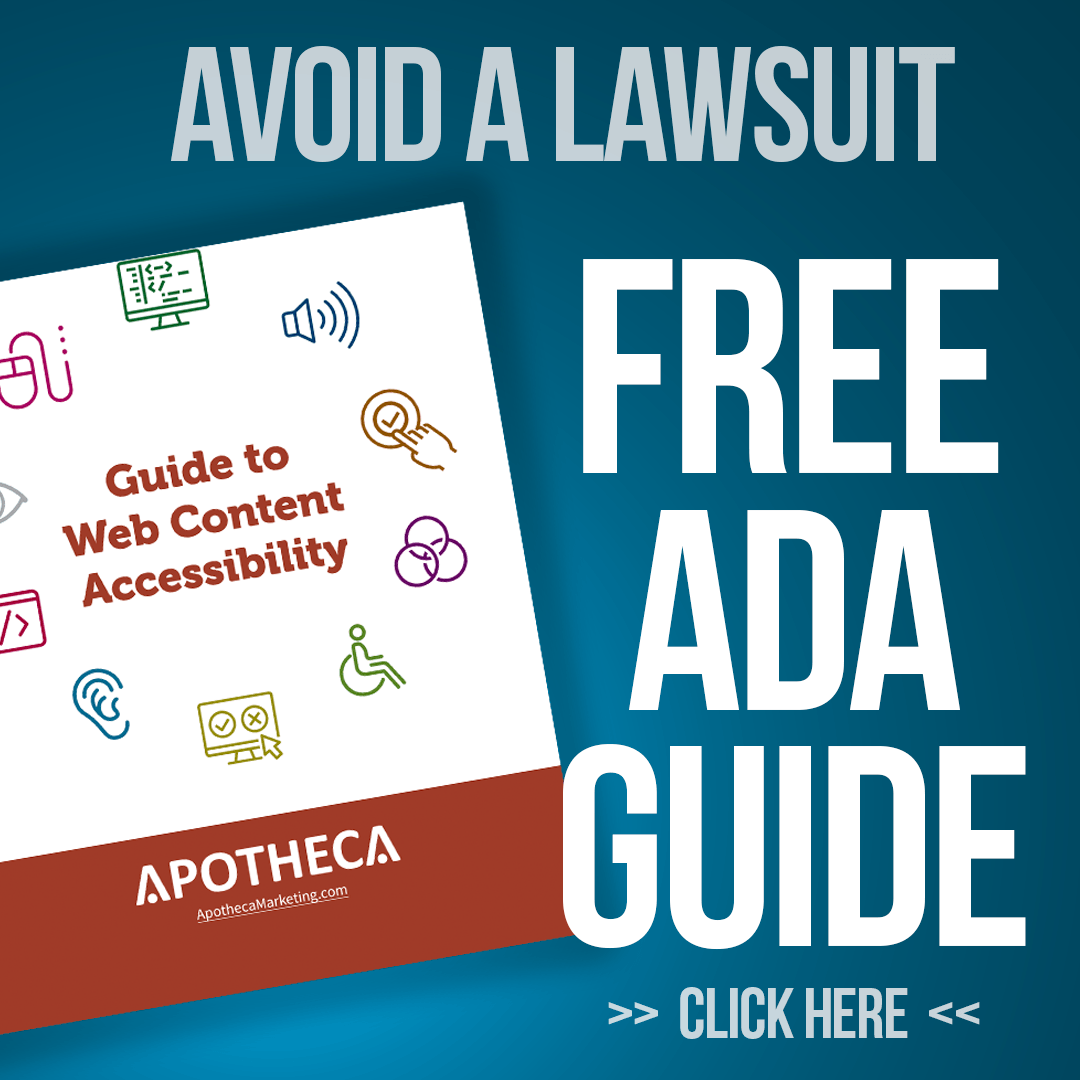Our Go-To Technical SEO Tool - Screaming Frog Demo
Roy Bielewicz
You can get a "free" audit of your site with this SEO tool.
There are a lot of SEO tools on the market, many of which are super expensive. We take a quick look at Screaming Frog, our go-to technical SEO auditing tool that is also super affordable. At least the free version is.
Transcription:
If you're like us, you've found that SEO tools can be pretty expensive and so are audits. Having a company come in and do a full assessment on your website can cost a lot of money. Not that they're not important, but there are less expensive ways to get the job done and so we're going to a take a look today at one of our favorite SEO tools that is relatively affordable if you use the free version. So hang around and we'll take a look at it.
Hey guys, Roy from Apotheca Marketing. Today we're going to a take a look at
Screaming Frog. It's one of our favorite go-to tools for
auditing websites for SEO as well as just technical issues. It is not inexpensive if you use the full version of it. It is a very handy tool. It's something that we always like to keep in our arsenal. It's on caliber with certain things like SEMRush or Ahrefs; those will provide more insight into what people are searching for from a keyword perspective.
Screaming Frog is going to a look at what your site is about. It's going to a look at the structure of your site, it's going to a look at errors on your site, all the way down to images and stuff like that. So we're going to a take a look at it. The reason we do recommend this is because, again, the free version, will scan up to 500 pages on your site.
For most websites, for a lot of small business websites, that might be all they need. That might be much more than their site actually entails. For retailers, you're probably going to a need something more robust but you can still at least see some of the main issues with your site. You can scan, like I said, up to 500 pages. You can also then do another scan and just look at a product page if you didn't get to the product pages. You can at least look at if that page structure has issues, because it's probably going to a be every product page on your site is going to a have the same issues so you can get a good look of what is going on on your site just using the free version.
Let's dive in and take a look at it. So as you can see here, I have this pulled up; this is the Screaming Frog Interface. Let's just take a look at a site that we work with. This does have more than 500 pages, so you're going to a see it give an error for that. So you can see it says 500 pages. It's going to a conduct the scan and you can see it has this crawl status up here. It'll show you how it's crawling and then you can see a running total of things that it's encountering. It has everything from the robust txt to html, JavaScript, CSS, images, you name it; it's got it all in here. All right, that crawl is at 50 percent or a hundred percent now. Over here you can see what it crawled and these are the individual pages. They're also in some cases JavaScript files. They could be other types of files as well.
One of the things that I find helpful is to go over here and choose what it is we want to look at. In this case, we may want to take a quick look at HTML pages. We can see the structure of the page and then if you scroll, you can actually see other information. Whether it has not found title tags. So you can see the title tags. You can see the length of the title tags so you can optimize those. You can also see the description. Meta description. All of these, obviously, are super helpful and you can very quickly kind of go down through and see, for instance, is a page missing a meta description, which we can see they are here. Those are missing. We can also see if the title tags are missing. Just from that alone, it can be super helpful to see if those basic kind of things are missing from a site.
Now over here it does have an issues tab and one of the things you can look at over here is the total numbers, but then under issues it's going to a highlight things that are either warnings or that are highly problematic; it'll kind of rank them. In this case you can see that there's some canonical issues going on. H1 tags missing. It looks like there's one of those missing and then it shows you over here the actual page that that is occurring on. So you can see like, okay, well that one might be an issue.
You can go through and look at highly problematic issues on the site very quickly. You can also look for broken links. You can look for those meta descriptions that are missing, the page titles that are missing. Again, it breaks it all out for you right here, which is super, super convenient.
Over here, you can actually then go through, and you know, obviously we showed the the HTML page stuff altogether, but here you can look at specific H1 tag. So again, I'm going to a go back to all, and this just shows for each page their H1 tag. This is helpful to also go through and take a look at potentially images that are way too large. This is a good way to scan for those. You can look at and actually filter
large images that might be way too big. So you can see like this guy is 1.3 megabytes; that's a pretty large image, especially when all of these other ones are coming in much smaller.
Again, you can go through and look at, for instance, just the meta descriptions. You can see the length, make sure it's hitting the ideal length, and you can see whether they're indexable or not and all of that good kind of stuff. Site structure is also important so you can see if there's stuff on here for instance that you don't want to get indexed. You can then go through and add that to your robots txt. Just make sure that those pages are not getting indexed if it's stuff that you don't want there. The structure will tell you like what folders and categories it's seeing and whether or not they're reachable. One of the things I like to do is take a look at the images on the pages and then you can even see down here whether they have alt tags or not.
This one will tell you all the details about the image, whether it's indexible, it's size. Remember this was the big one that we saw but you can also then take a look at whether they have alt tags, so this will show you where this image has been used and whether it has alt texts. You can see for instance, this image for some reason does not have alt texts in all of its occurrences.
This is a great way to go through and look and make sure that all of your images have alt tags cause they should. We talked about that actually in a recent video about how not only is that good for SEO and important for SEO, but if you don't have basic usability and accessibility stuff like alt tags and like descriptions on your site, you could be setting yourself up for a lawsuit. We'll put a link to that in the video, in the description below. You don't want that, you don't want a lawsuit, I can guarantee you. So this is a good way to be able to go through and say, Hey, all of these images need alt tags. The other nice thing is that you can export this and so once you've gone through and kind of figured out what's going on with the site, if you want this as an an Excel spreadsheet, super easy to export.
You can do that right here and you can actually then also send that to
Google Sheets if you want. We're just taking a brief look at, you know, some of the basic functionality that you get with this free version, but there is a lot more stuff that you can do with the paid version. There's a lot that we're not going to a dive into today.
For instance, you can restrict the number of product pages that it scans so that you know if they're all going to a have similar problems and you have 10,000 products or 20,000 products, you don't need to scan all of them probably. You can get a sense of what's going on with some of those pages without spending your crawl budget on that.
Again, it's one of those things that as you play around with it, you're going to a find great information about what's going on in your site. It's a quick way to do an assessment without having to spend a whole bunch of money. Again, it's not going to a tell you about keywords that people are searching for.
It's not going to a tell you about competitors’ keywords that they're using and that they're bidding on, or that they're ranking for an SEO. That's the realm of tools like SEM Rush and Ahrefs. This is really much more about your technical SEO on your website and some of the things that you can improve easily.
Again, it's free. We highly recommend Screaming Frog. We don't make any money by telling you that. We are not an affiliate or anything, but it's something that you can download and start using tomorrow and you know, see more about your.
Hey, if this was useful for you, let us know. Leave comments. What tools do you like to use for SEO and what have you found useful? Are there other tools that are free that you also like to use, or low cost? We'd love to hear about it and if you could give us a like, that would be great. And of course subscribe as we do more content like this, and we'll talk to you soon.
Contact Us





